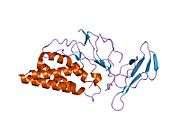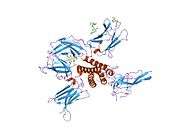IL2RA
| View/Edit Human | View/Edit Mouse |
Interleukin-2 receptor alpha chain is a protein that in humans is encoded by the IL2RA gene.[4]
The interleukin 2 (IL2) receptor alpha (IL2RA) and beta (IL2RB) chains, together with the common gamma chain (IL2RG), constitute the high-affinity IL2 receptor. Homodimeric alpha chains (IL2RA) result in low-affinity receptor, while homodimeric beta (IL2RB) chains produce a medium-affinity receptor. Normally an integral-membrane protein, soluble IL2RA has been isolated and determined to result from extracellular proteolyisis. Alternately-spliced IL2RA mRNAs have been isolated, but the significance of each is currently unknown.[5]
Infection by the protozoan Trypanosoma cruzi causes Chagas disease, characterized by a reduction in the amount of IL2RA expressed on the surface of immune cells. This leads to chronic immune suppression, becoming increasingly severe over the course of many years and ultimately resulting in death if left untreated.
References
- ↑ "Diseases that are genetically associated with IL2RA view/edit references on wikidata".
- ↑ "Human PubMed Reference:".
- ↑ "Mouse PubMed Reference:".
- ↑ Leonard WJ, Donlon TA, Lebo RV, Greene WC (Aug 1985). "Localization of the gene encoding the human interleukin-2 receptor on chromosome 10". Science. 228 (4707): 1547–9. doi:10.1126/science.3925551. PMID 3925551.
- ↑ "Entrez Gene: IL2RA interleukin 2 receptor, alpha".
Further reading
- Kuziel WA, Greene WC (June 1990). "Interleukin-2 and the IL-2 receptor: new insights into structure and function". J. Invest. Dermatol. 94 (6 Suppl): 27S–32S. doi:10.1111/1523-1747.ep12875017. PMID 1693645.
- Waldmann TA (February 1991). "The interleukin-2 receptor". J. Biol. Chem. 266 (5): 2681–4. PMID 1993646. Retrieved 2008-08-04.
- Murakami S (September 2004). "Soluble interleukin-2 receptor in cancer". Front. Biosci. 9: 3085–90. doi:10.2741/1461. PMID 15353339. Retrieved 2008-08-04.
- Vincenti F (September 2004). "Interleukin-2 receptor antagonists and aggressive steroid minimization strategies for kidney transplant patients". Transpl. Int. 17 (8): 395–401. doi:10.1007/s00147-004-0750-3. PMID 15365604. Retrieved 2008-08-04.





